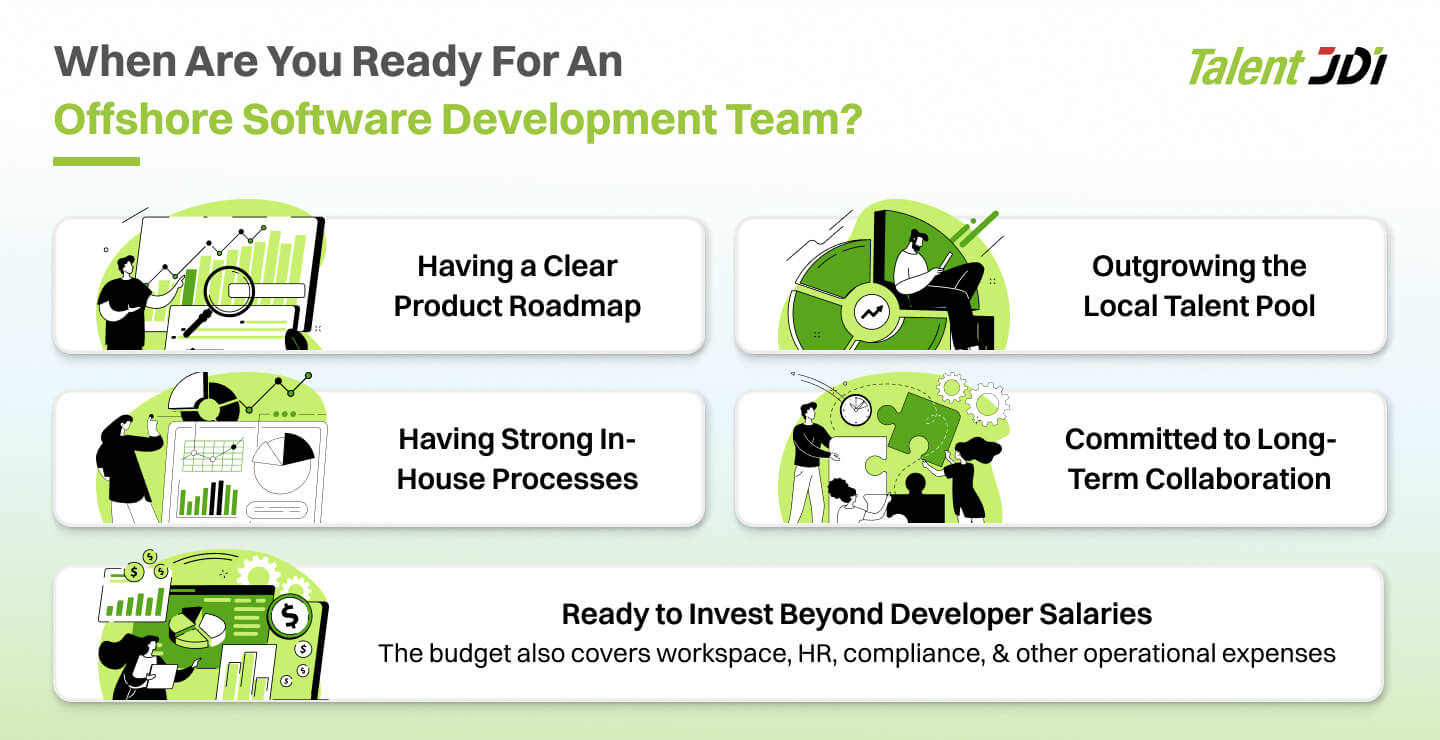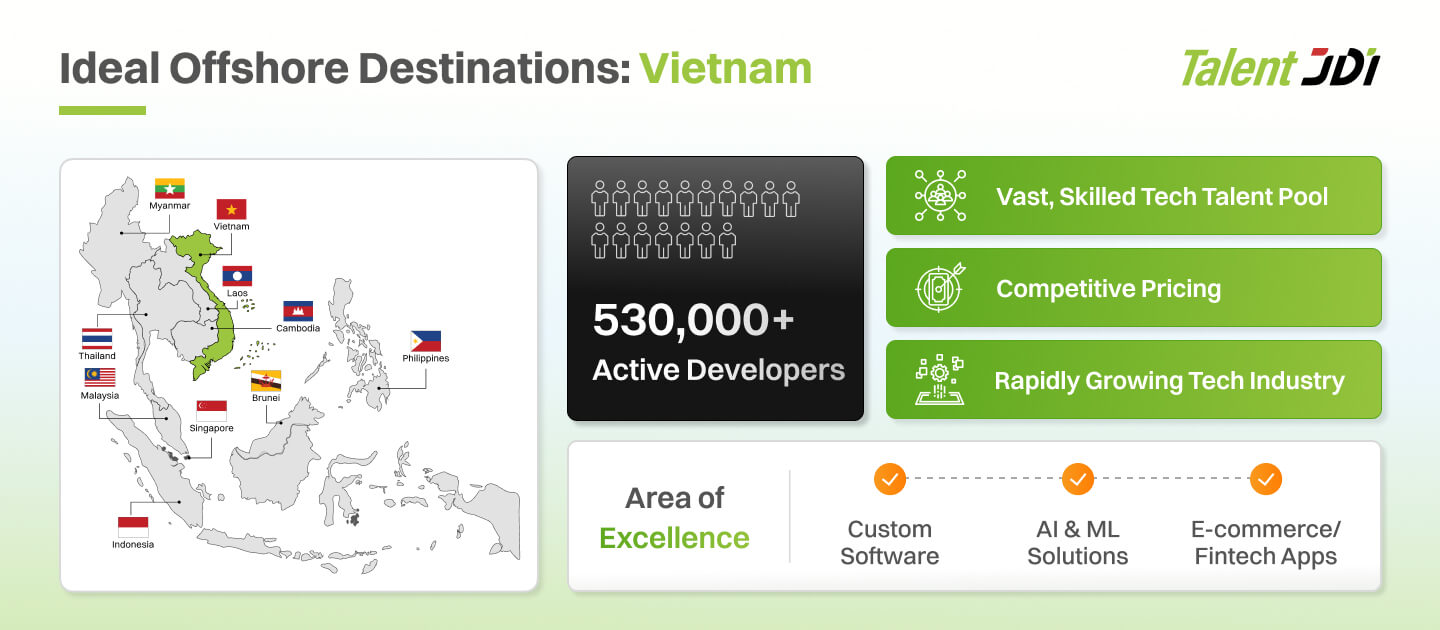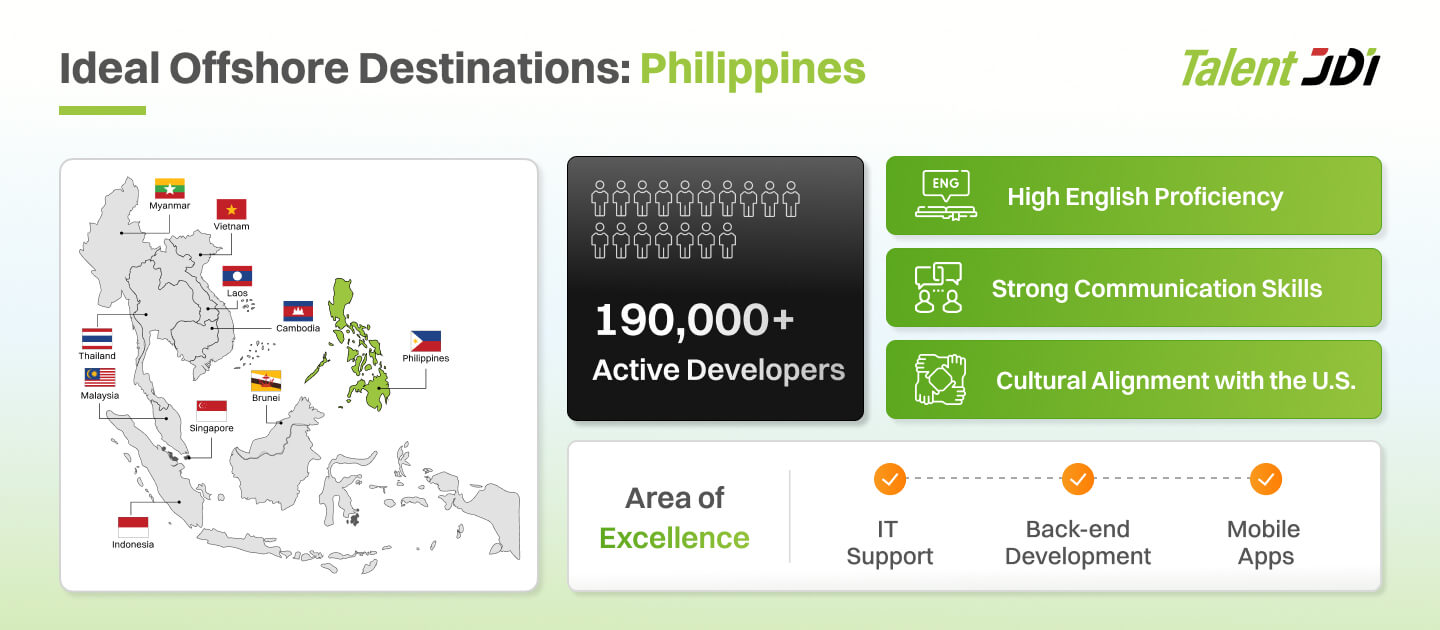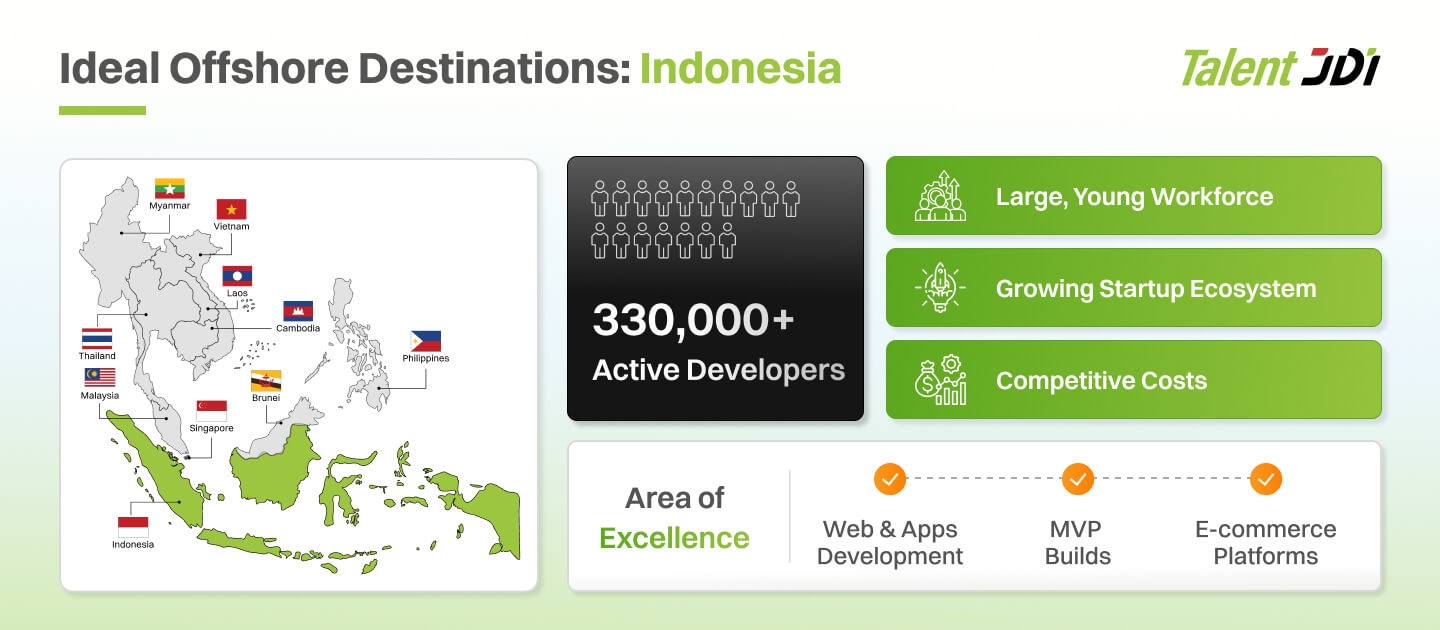
Offshore Software Development Team Models: Build, Buy, or Partner?
AUTHOR
Talent JDI
READ TIMES
1 minutes
LAST UPDATED
Nov 17, 2025
As companies look to scale their ability to deliver tech projects, turning to an Offshore Software Development Team has become a practical move. It opens access to global talent, reduces development costs, and helps speed up timelines.
In this article, we’ll explore the different offshore software development models companies can leverage, weigh the pros and cons of each, and offer guidance on how to choose the right fit for your business.
What Exactly is an Offshore Software Development Team?

Let’s clear something up — because “offshore software development” gets thrown around a lot, and not everyone means the same thing when they say it.
At its core, offshore software development just means getting your tech done in another country. That’s it. You’re tapping into a talent pool somewhere cheaper, faster, or more scalable than wherever you are. Think: great engineers, lower costs, fewer hiring headaches.
But here’s where things split.
Some companies want their own offshore team — folks who work exclusively for them, like a remote branch of their internal dev squad. Others just hand off the work entirely to a third-party agency that delivers the code, no strings attached.
Two approaches. Different vibes. Both totally valid. And yes, we’ll get into the pros and cons of each.
Comparison | Outsourcing to an Offshore Software Development Team | Offshore Software Development Team Under Your Control |
| Ownership | None | Full ownership of the team, output, and IP |
| Quality Control | Limited control; depends on vendor’s process (approx. 60% of in-house standards) | Strong control over hiring, workflows, and output (approx. 80%~90% of in-house standards) |
| Cost | Low for short-term or simple work | More expensive upfront, but cost-effective for long-term or complex work |
| Responsibilities | Minimal — vendor manages timelines, talent, and delivery | Medium to high — you manage team culture, performance, and productivity |
| Flexibility | Low — harder to change team composition or direction mid-project | High — you can adapt, scale, or restructure as needed |
| Scalability | Limited by the vendor’s team capacity and priorities | High — you can build a custom team based on your growth roadmap |
| Integration with the Core Team | Minimal — the external team often works separately | Strong — the offshore team can operate like a remote extension of your in-house unit |
In this article, we will focus on setting up and running an offshore software development team under your own control, across various models that offer varying levels of ownership and flexibility.
If you’re more interested in outsourcing the work entirely, we’ve also put together a detailed guide — check it out here.
For more detailed insights: Outsourcing and Offshoring: What Is The Difference?
When Are You Ready for an Offshore Software Development Team?

Setting up an offshore tech team can be a smart move — but only if you’re truly prepared. Use the checklist below to evaluate whether now’s the right time for your business to go offshore.
1. You Have a Clear Product Roadmap
An offshore team can’t operate effectively if the product direction is vague or constantly shifting. You need a strong internal sense of where your product is going, what the technical requirements are, and how progress will be measured. Without this clarity, misalignment grows fast.
✔️ You’ve outlined core features and technical goals
✔️ Your internal product or engineering lead can provide day-to-day direction
✔️ You're not constantly pivoting
2. You’ve Outgrown Your Local Talent Pool
When your local market can’t meet your hiring needs — either due to cost, speed, or skillset — it might be time to look offshore. This is a common scenario for startups and scaleups trying to move quickly without breaking the bank.
✔️You're struggling to fill technical roles at home
✔️ Salary expectations in your local market are unsustainable
✔️ You’ve identified skill gaps that offshore markets can fill
3. You’re Ready to Invest Beyond Developer Salaries
Cost savings are a benefit, but offshoring isn’t free. Setting up and running a dedicated offshore team comes with operational costs — workspace, HR, legal, equipment, and management overhead. If you’re thinking long term, it’s not about saving money upfront — it’s about investing smartly to build a scalable, reliable extension of your tech team.
✔️ You’ve allocated budget for workspace, tools, HR, compliance, etc.
✔️ You understand there are ongoing management and operational costs
✔️ You’re not treating it as a short-term fix
4. You Have Strong In-House Processes
Offshore teams don’t perform well without structure. If your internal team already works with clear processes — defined sprints, documentation, daily standups — then onboarding remote developers becomes much easier. Offshore talent needs to plug into a working system, not chaos.
✔️ You already have clear workflows, documentation, and development cycles
✔️ Your teams use tools like Jira, GitHub, Slack, etc.
✔️ Your internal team can onboard and collaborate with external engineers
5. You’re Committed to Long-Term Collaboration
Successful offshore development isn’t about throwing specs over the wall and hoping for the best. It’s about building trust, loyalty, and long-term velocity. If you want a team that understands your product deeply and grows with your business, you need to treat them like a core part of your company.
✔️ You want to grow and retain the team, not just churn out features
✔️ You’re thinking beyond short-term contracts or projects
✔️ You’re open to treating your offshore team as a core part of the business
Offshore Software Development Team Models
Not all offshore strategies are built the same. Whether you’re a startup eyeing expansion or an enterprise planning long-term product development, choosing the right model can save time, money, and stress.
Here’s a practical breakdown of four common models — and how to decide which one’s right for your stage, goals, and resources.
Category | Build – Wholly-Owned Tech Team | Buy – Team Acquisitions | Partner – Joint-Venture Option | Partner – Build-Operate-Transfer (BOT) |
Definition | You set up and run your own offshore entity, fully owning and managing the team and operations. | You acquire an existing offshore team or company to get instant access to talent and setup. | You co-own the team with a local partner and share costs, risks, and decisions. | A partner sets up and manages the offshore team, then transfers full ownership when ready. |
Pros | - Full control - Strong IP protection - Long-term cost efficiency | - Quick entry - Ready-made team - No need to build from scratch | - Shared cost and risk - Access to local networks and support | - Fast start - Low risk - Smooth transition to full ownership |
Cons | - High upfront cost - Needs local legal/tax knowledge - Slower to scale | - Expensive - Potential integration or cultural mismatch | - Split control - Slower decision-making - Shared profits | - Requires trust in the partner - Handover timing can be tricky |
Best For | Companies with long-term vision, in-house ops capability, and large budgets | Companies that need speed and want access to niche skills, or are looking to buy rather than build | Companies entering new markets without local experience, or those testing the waters before full ownership | Startups or mid-sized firms wanting speed + future control without full upfront commitment |
Ideal Countries for An Offshore Software Development Team
Offshoring your software team? Plenty of countries could make the list, but a few usual suspects aren’t on ours.
The US, most of Europe, and Singapore have top-tier talent. But when it comes to building cost-effective, scalable teams? They don’t stack up. Prices are high, talent competition is intense, and hiring at speed is rarely easy. If you're targeting those markets or have the budget to match, it can make sense, but it's not the typical offshore play.
Then there’s China and India. Still global giants in tech outsourcing, still producing engineers at scale. But they’re no longer the low-cost havens they once were. And for companies prioritizing cultural fit, ease of travel, and smooth collaboration, both can be tricky. Time zones, work styles, and logistics often get in the way.
For us, ideal offshore countries strike a smarter balance: closer (geographically or culturally) to HQ in ASIA, packed with capable developers, and still cost-friendly enough to justify building a dedicated team. That’s the lens we’re using here, and the reason some big names didn’t make the cut.
Discover more options to set up your tech team: Best Countries to Hire Offshore Developers in 2025
Vietnam

Vietnam is emerging as a top offshore destination in Asia, offering a balance between quality and affordability. Its tech sector is booming, and the country has a growing reputation for delivering high-quality software for startups and enterprises alike.
- Strengths: Rapidly growing tech industry, competitive pricing, cultural compatibility with Western clients
- Languages: English proficiency improving
- Popular For: Custom software, AI & ML, e-commerce, fintech apps
- Estimated Developer Pool: ~530,000+ developers
Philippines

The Philippines is known for its excellent communication skills and strong cultural alignment with the US. While often associated with BPO services, it also has a solid base of skilled software developers, making it a good choice for teams that require a high level of collaboration.
- Strengths: High English proficiency, strong communication skills, cultural alignment with the US
- Languages: English is an official language
- Popular For: Customer support, back-end development, mobile apps
- Estimated Developer Pool: ~190,000+ developers
Indonesia

Indonesia has a rapidly growing developer base and a vibrant startup culture, especially in Jakarta, Bandung, and Yogyakarta. While still developing compared to regional leaders, it's a promising market for companies looking for lower-cost alternatives in Southeast Asia.
- Strengths: Large, young workforce; growing startup and developer ecosystem; competitive costs
- Languages: English proficiency varies but is improving in tech sectors
- Popular For: Web development, mobile apps, e-commerce platforms, and MVP builds
- Estimated Developer Pool: ~330,000+ developers
Explore our latest Vietnamese developer salary report — and see how it stacks up against the Philippines, Indonesia, Singapore, and other key markets.
Build a High–Performing Tech Team With Talent JDI
Getting an offshore software development team isn’t just about cutting costs—it’s about building the right setup to support your services, products, and long-term growth.
Whether you build a wholly owned team from the ground up, buy through a team acquisition, or partner via a joint venture or BOT model, each approach comes with trade-offs. Building offers control, buying gives you speed, and partnering brings flexibility and shared risk.
The right model depends on your stage, budget, and appetite for ownership. But done right, any of these paths can unlock access to global talent, increase delivery capacity, and future-proof your tech operations.
That’s where Talent JDI comes in.
With a network of 16,000+ skilled tech candidates, Talent JDI helps businesses secure top tech talent in a matter of weeks.
We handle the heavy lifting—from sourcing and vetting candidates to onboarding and operational support—so you can stay focused on building and scaling. More than just a service provider, we act as a long-term partner, helping over 200 global businesses tap into Vietnam’s deep tech talent pool and drive innovation at scale.
Ready to find the right model—and the right people—to grow your team? Let’s talk.
